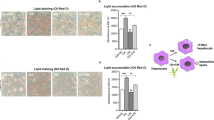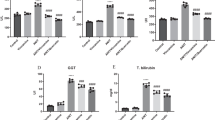Abstract
Hepatocellular carcinoma is the second most cause of death among the various cancers worldwide. Recent research searching an alternative therapy for cancer treatment without or less side effects. Many studies indicated the beneficial effects of Enhalus acoroides. There has been no scientific validation on antioxidant and chemopreventive potential of ethanolic extract E. acoroides against hepatoma. To assess the hepatoprotective activity of E. acoroides (EEEA) against DEN-induced hepatoma using Wistar albino rats. Animals were distributed into five groups, each containing six rats. To Group I — control rats — normal saline given. Groups II, III, IV and V rats were injection of DEN at a dose of 100 mg/kg body weight i.p. to induce liver cancer. At the commencement of 6th week, Group III rats supplemented with EEEA at a dose of 200 mg/kg body weight/day upto 16 weeks. Group IV rats supplemented with EEEA for 1 week before the administration of DEN and continued till the sixteenth week. Group V supplementation of silymarin at a dose of 100 mg/kg body weight at the beginning of 6th week after the injection of DEN and continued upto 16 weeks and considered as positive control rats. The efficiency of E. acoroides for its antioxidant hepatoprotective and activity evaluated in rats against DEN-induced liver damage. The hepatoprotective ability of EEEA at a dose of 200 mg/kg was examined against DEN at a dose of 100 mg/kg/b.w. induced hepatotoxicity and analysed by evaluating serum liver and kidney marker levels, lipid profile (TG, HDL, LDL and total cholesterol) and serum tumour markers (DNA, RNA, AFP and CEA). Supplementation of EEEA to DEN treated rats was determined by evaluating various antioxidant biomarkers (SOD, CAT, GPx, GSH, Vit E and Vit C). Histopathological studies and morphometric gross analysis were also support the consequences of this study. A significant improvement of antioxidant defence and declined MDA levels within the serum of EEEA treated animals compared to the DEN-induced hepatoma. The supplementation of EEEA declined the serum liver, kidney and serum tumour marker levels and lipid profile as comparatively to Group I rats. The histopathological changes were changed on supplementation of EEEA demonstrating its protecting effects on hepatocytes as comparatively to Group I rats. Our significances recognized that crude extract (ethanol) of E. acoroides revealed a potential impact against DEN-induced hepatoma and assists as a superior choice for chemopreventive treatments.






Similar content being viewed by others
Data Availability
If required will share the data.
Code Availability
Not applicable.
References
Gibbs, J. B. (2000). Mechanism-based target identification and drug discovery in cancer research. Science., 287(5460), 1969–73. https://doi.org/10.1126/science.287.5460.1969 PMID: 10720316.
Jeena, K.J., Joy, K.K., Kuttan, R. (1999). Effect of Emblica officinalis, Phyllanthus omarus and Pierorrhiza kurron on N-nitrosodiethylamine induced hepatocarcinogenesis. Cancer Letter, 136, 11–16.
Martins, A., Vieira, H., Gaspar, H., & Santos, S. (2014). Marketed marine natural products in the pharmaceutical and cosmeceutical industries: Tips for success. Marine Drugs, 12, 1066–1101.
Rengasamy, K. R., Arumugam, R., Saravanan, M., & Anantharaman, P. (2010). Thin layer chromatography analysis of antioxidant constituents of seagrasses of Gulf of Mannar. International Journal ChemTech Research., 2, 1526–1530.
Ramakrishnan, G., Raghavendran, H. R., Vinodhkumar, R., & Devaki, T. (2006). Suppression of N-nitrosodiethylamine induced hepatocarcinogenesis by silymarin in rats. Chemico-Biological Interactions, 161(2), 104–114. https://doi.org/10.1016/j.cbi.2006.03.007 Epub 2006 Mar 22 PMID: 16643877.
Flora, K., Mahn, M., Rosen, H., & Benner, K. (1998). Milk Thistle (Silybzrm tnnrinzurn) for the therapy of liver diseases. Am J Gnstroenterol, 93, 139–143.
Amudha, P., & Vanitha, V. (2019). Toxicological, biochemical and histopathological evaluation of the ethanolic extract of seagrass - Enhalus acoroides in albino Wistar rats. Biocatalysis and Agricultural Biotechnology, 18, 101082. https://doi.org/10.1016/j.bcab.2019.101082
Balamurugan, K., & Karthikeyan, J. (2012). Evaluation of luteolin in the prevention of N nitrosodiethylamine-induced hepatocellular carcinoma using animal model system. Ind J Clin Biochem, 27(2), 157–163.
Dacie, S.J. V., & Lewis, S.M. (1984). Practical haematology (Eds.), (pp. 22–27). Edinburgh: Churchill Livingstone.
Ochei, J., & Kolhatkar, A. (2000). Medical laboratory science. Theory and practice. 2nd Ed. (pp. 331–349). New Delhi: Tata Mcgraw-Hill Publishing.
Reitman, S., & Frankel, S. (1957). A colorimetric method for the determination of serum glutamic oxaloacetic and glutamic pyruvic transaminase. Am J Clin Path, 25, 56.
Kind, E. J., & King, R. P. N. (1954). Determination of alkaline phosphatase activity by colorimetric method. J. Clin. Path, 7, 322.
Lowry, O. H., Rosenbrough, N. J., Farr, A. L., & Randall, R. J. (1951). Protein measurement with the Folin’s reagent. Journal of Biological Chemistry, 193, 265–276.
Natelson, S. (1957). Microtechniques of Clinical Chemistry: For the Routine Laboratory. CC Thomas. http://pi.lib.uchicago.edu/1001/cat/bib/2226331.
Boneses, R. N., & Taussk, H. A. (1945). On the colorimetric determination of creatinine by the Jaffe reaction. Journal of Biological Chemistry, 158, 581–591.
Malloy, H. T., & Evenlyn, K. A. (1937). The determination of bilirubin with the photometric colorimeter. Journal of Biological Chemistry, 119, 481.
Rodkey, F. L. (1965). Direct spectrophotometric determination of albumin in human serum. Clinical Chemistry, 11, 478–479.
Werner, M., Gabrielson, D. G., & Eastman, G. (1981). Ultramicro determination of serum triglycerides by bioluminescent assay. Clinical Chemistry, 27, 268–271.
Allain, C. C., Poon, L. S., Chan, C. S. G., Richmond, W., & Fu, P. C. (1974). Enzymatic determination of total serum cholesterol. Clinical Chemistry, 20, 470–475.
Friedwald’s, W.T., Levy, R.T. and Fredrickson, D.S. (1972). Estimation of low-density lipoprotein cholesterol in plasma, without use of the preparative centrifuge. Clinical Chemistry, 23, 499.
Moron, M. S., DsePierre, J. W., & Manerwik, K. B. (1979). Levels of glutathione, glutathione reductase and glutathione-s-transferase activities in rat lung and liver. Biochimica et Biophysica Acta, 582, 67–68.
Beers, R., & Sizer, I. (1952). A spectrophotometric method for measuring the breakdown of hydrogen peroxide by catalase. Journal of Biological Chemistry, 195, 133.
Kakkar, P., Das, B., & Viswanathan, P. N. (1984). A modified spectrophotometric assay of SOD. Indian J Biochem Bio, 21, 130–132.
Rotruck, J. T., Pope, A. L., Ganther, H. E., Swanson, A. B., Hafeman, D. G., & Hoekstra, W. G. (1973). Selenium: Biochemical roles as component of glutathione peroxidase. Science, 179, 588–590.
Omaye, S. T., Tumball, J. D., & Sauberlich, H. E. (1979). Selected methods for the determination of ascorbic acid in animal cells, tissues and fluids. Method Enzymol, 62, 1–11.
Baker, H., Frank, O., Angelis, B. D., & Feingold, S. (1951). Plasma tocopherol in man at various times after ingesting free or acetylated tocopherol. Nutrition reports international, 21, 531–536.
Song, Y., Jin, S., Cui, L. H., Ji, X. J., & Yang, F. G. (2013). Immunomodulatory effect of Stichopus japonicus acid mucopolysaccharide on experimental hepatocellular carcinoma in rats. Molecules, 18, 7179–7193.
Furuta, K., Sato, S., Miyake, T., Okamoto, E., Ishine, J., Ishihara1, S., Amano, Y., Adachi, K. and Kinoshita, Y. (2008). Anti-tumor effects of cimetidine on hepatocellular carcinomas in diethylnitrosamine-treated rats. Oncol. Rep 19, 361–368. https://doi.org/10.3892/or.19.2.361.
Sayed-Ahmed, M.M., Aleisa, A.M., Al-Rejaie, S.S., Al-Yahya, A.A., Al-Shabanah, O.A., Hafez, M.M., and Nagi, M.N. (2010). Thymoquinone attenuates diethylnitrosamine induction of hepatic carcinogenesis through antioxidant signaling. Oxidative medicine and cellular longevity, 3 (4), 254–261. https://doi.org/10.4161/oxim.3.4.12714
Banakar, M.C., Paramasivan, S.K., Chattopadhyay, M.B., Datta, S., Chakraborty, P., Chatterjee, M., Kannan, K. and Thyagarajan, E. (2004). 25-dihydroxyvitamin D3 prevents DNA damage and restores antioxidant enzymes in rat hepatocarcinogenesis induced by diethylnitrosamine and promoted by phenobarbitol. World J Gastroenterol 10(9), 1268–1275. https://doi.org/10.3748/wjg.v10.i9.1268.
Morsy, A.F., Ibrahim, H.S., & Shalaby, M.A. (2010). Protective effect of broccoli and red cabbage against hepatocellular carcinoma induced by N-nitrosodiethylamine in rats. American Journal of Science 6(12), 1136–44.
George, J. (2003). Ascorbic acid concentrations in dimethylnitrosamine-induced hepatic fibrosis in rats. Clinica Chimica Acta, 335, 39–47.
Klaunig J.E., and Kamendulis L.M. (2010). Chapter 8. Chemical carcinogenesis. Klaassen C.D., & Watkins J.B., III(Eds.), Casarett & Doull's Essentials of Toxicology, 2e. McGraw Hill. https://accesspharmacy.mhmedical.com/content.aspx?bookid=449§ionid=39910775
Tong, T., Liu, Y. J., Kang, J., Zhang, C. M., & Kang, S. G. (2019). Antioxidant activity and main chemical components of a novel fermented tea. Molecules (Basel, Switzerland), 24(16), 2917. https://doi.org/10.3390/molecules24162917
Ighodaro, O. M., & Akinloye, O. A. (2018). First line defence antioxidants-superoxide dismutase (SOD), catalase (CAT) and glutathione peroxidase (GPX): Their fundamental role in the entire antioxidant defence grid. Alexandria Journal of Medicine, 54(4), 287–293. https://doi.org/10.1016/j.ajme.2017.09.001
Malati, T. (2007). Tumour markers: An overview. Indian journal of clinical biochemistry: IJCB, 22(2), 17–31. https://doi.org/10.1007/BF02913308
Thirunavukkarasu, C., Premkumar, K., Jagadeeswaran, R., & Sakthisekaran, D. (2005). The inhibitory effect of sodium selenite on N-nitrosodiethylamine-induced and phenobarbital promoted liver tumourigenesis in rats based on the modulation of polyamine levels. Molecular and Cellular Biochemistry, 280(1–2), 165–172.
Abelev, G. I. (1971). Alpha - Fetoprotein in association with malignant tumors. Advances in Cancer Research, 14, 295–357.
PakkirMaideen, N. M., Velayutham, R., & Manavalan, G. (2012). Role of prosopis cineraria against N-nitrosodiethylamine-induced liver tumor in rats with reference to marker enzymes and nucleic acid contents. Bangladesh Journal of Pharmacology, 6(2), 128–132. https://doi.org/10.3329/bjp.v6i2.9027
Sadik, N., El-Maraghy, S., & Ismail, M. (2008). Diethylnitrosamine-induced hepatocarcinogenesis in rats: Possible chemoprevention by blueberries. African Journal of Biochemistry Research., 2, 81–87. https://doi.org/10.5897/AJBR.9000075
Rocchi, E., Seium, Y., Camellini, L., Casalgrandi, G., Borghi, A., Alimonte, P., & Cioni, G. (1997). Hepatic tocopherol content in primary hepatocellular carcinoma and liver metastases. Hepatology, 26, 67–72.
Iqbal, J., Minhajuddin, M., & Beg, Z. H. (2004). Suppression of diethylnitrosamine and 2- acetylaminoflurene induced hepatocarcinogenesis in rats by tocotrienol rich fraction isolated from rice bran oil. Eur J Can Prev, 13, 515–520.
Kannappan, P., & Gopalakrishnan, V. K. (2014). Anticancer activity of Tabernaemontana coronaria against carcinogen induced clear cell renal cell carcinoma. Chinese Journal of Biology., 2014, 1–8. https://doi.org/10.1155/2014/584074
Ge, J.N., Yu, J.C., Kang, W.M., Ma, Z.Q., & Gu, Y.C. (2011). Investigation of tumor related anemia in 10,218 patients with cancer in the digestive system Chinese journal of gastrointestinal surgery, 14(5), 340–342. PMID: 21614687.
Hassan, N. F., Soliman, G. M., Okasha, E. F., & Shalaby, A. M. (2018). Histological, immunohistochemical, and biochemical study of experimentally induced fatty liver in adult male albino rat and the possible protective role of pomegranate. J Microsc Ultrastruct, 6(1), 44–55.
Youssef, M. I., Maghraby, H., Youssef, E. A., & El-Sayed, M. M. (2012). Expression of Ki 67 in hepatocellular carcinoma induced by diethylnitrosamine in mice and its correlation with histopathological alterations. Journal of Applied Pharmaceutical Science., 2, 52–59.
Author information
Authors and Affiliations
Contributions
The corresponding author PA designed the protocol, assistance in animal euthanasia and supervised the research work. MJ executed the experiment — efficacy of EEEA in hepatocellular carcinoma using Wistar albino rats and euthanasia of the animals. RV: assistance in animal euthanasia. BNP helped in writing of the manuscript. All authors read and approved the final manuscript.
Corresponding author
Ethics declarations
Submission declaration
The present work has not been published previously in any form and not under consideration for publication elsewhere.
Ethics Approval
The procedure was done according to the guidelines of the Committee for the Purpose of Control and Supervision of Experiments on Rats (CPCSEA), New Delhi, India (IAEC No: XXI/VELS/PCOL/02/2000/CPCSEA/IAEC/01.12.2017).
Consent to Participate
Not applicable.
Consent for Publication
Not applicable.
Conflict of Interest
The authors declare no competing interests.
Additional information
Publisher's Note
Springer Nature remains neutral with regard to jurisdictional claims in published maps and institutional affiliations.
Supplementary Information
Below is the link to the electronic supplementary material.
Rights and permissions
About this article
Cite this article
Amudha, P., Jayalakshmi, M., Vidya, R. et al. Chemopreventive and Therapeutic Efficacy of Enhalus acoroides against Diethylnitrosamine Induced Hepatocellular Carcinoma in Wistar Albino Rats. Appl Biochem Biotechnol 195, 2597–2617 (2023). https://doi.org/10.1007/s12010-022-03832-9
Received:
Accepted:
Published:
Issue Date:
DOI: https://doi.org/10.1007/s12010-022-03832-9




